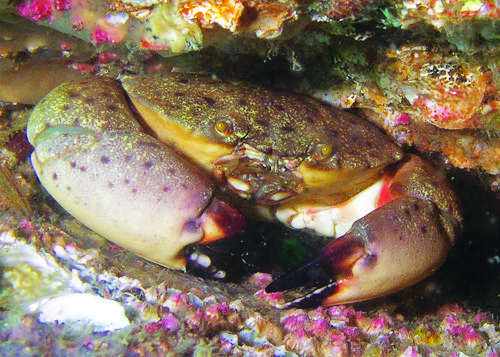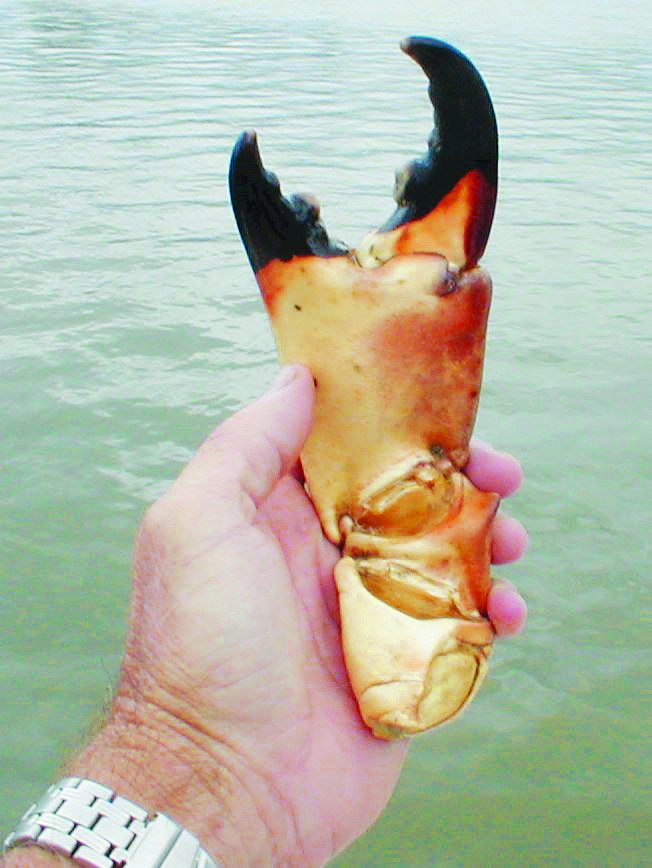Capt. Chad Carney
Early in 1978 I got my first chance to hunt stone crabs, scuba diving under the Skyway Bridge across Tampa Bay. Cold dark water at sunrise, my buddy and I couldn’t see past 4-feet, but it was just enough to descend on rows of concrete pilings meeting the sand and rocks in strong current. Stone crabs thrived there! Of course we lost each other, but came ashore carrying mesh bags stuffed with enough tasty claws for a big dinner for all that night. Ever since, my favorite seafood is stone crab claws!
Novice crabbers have trouble approaching stone crabs that resemble Dwayne ‘The Rock’ Johnson vs other crab’s Justin Bieber-like appearance. People think I’m nuts when I tell them, “Just set fear aside and pounce on them with your whole hand. Hunt like an octopus!” Cover them up, pinning both claws at once, then drag them out and get a hold of each claw. If they start to pinch, try slipping your finger back, leaving them nothing but glove. Their pinch hurts but it’s not going to take off a finger. They tire quickly and can’t keep the pressure on, so pull away quickly. If you fiddle around with them you won’t be eating much for dinner! By pinning one claw to the crab you can measure the larger one (against a notch cut in a crowbar), then apply steady pressure out and down, and it will break cleanly, or the crab will “drop” the claw. Stop if it starts to tear, this will kill the crab. Bag the claw and put the crab immediately back in its hole where it can defend itself. Stone crabs are a unique and sustainable fishery because they regenerate a new claw after losing one. It’s legal to take both claws of size, but they recover faster if they have one claw to collect more food.
Tools you’ll need: The above mentioned small crow bar is mostly used to block their retreat into holes, move rocks and pull yourself along the bottom. Cut a notch at 2 7/8-inches from the bars end, it’s the new claw size regulation. A thin bright dive light, tough Dyneema or Kevlar gloves, a sharp stiletto knife, a small wide mouth mesh bag, that will hold your one gallon limit, and don’t forget your dive flag float.
Keep your claws in a bucket half full of seawater, not on ice. Always boil all of them for about 5 minutes before refrigerating or freezing any. Otherwise they will stick to the shell. Rinse them with freshwater, melt some butter and serve hot, or make a Dijon sauce and serve cold. Mmmm! By the way large channel-lock pliers will crack them better than nut crackers or hammers. There are professional table claw crackers.
Stone crabs have had a tough time the last few years, so for 2020 legal stone crab claws will have to be 2 7/8th-inches across the bottom fixed part, that’s up an 1/8th-inch for the season starting October 15, 2020. The season will also close May 2nd instead of May 15th. See myfwc.com for regulations, photos & videos of how to measure and remove a claw. Crab trap pullers have more changes, also on the website.
Captain Chad Carney – Scuba Diving, Freediving & Spearfishing Instructor
Contact info: Florida Skin Diver 727-423-7775


